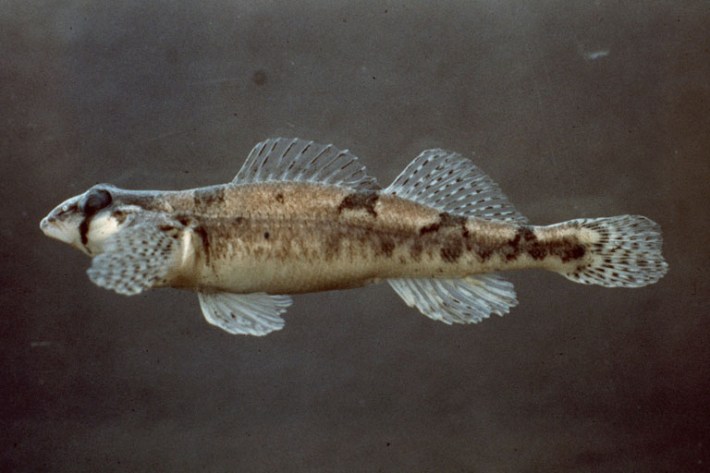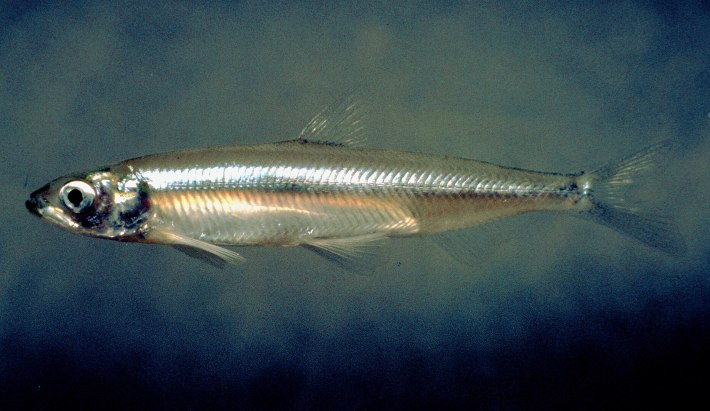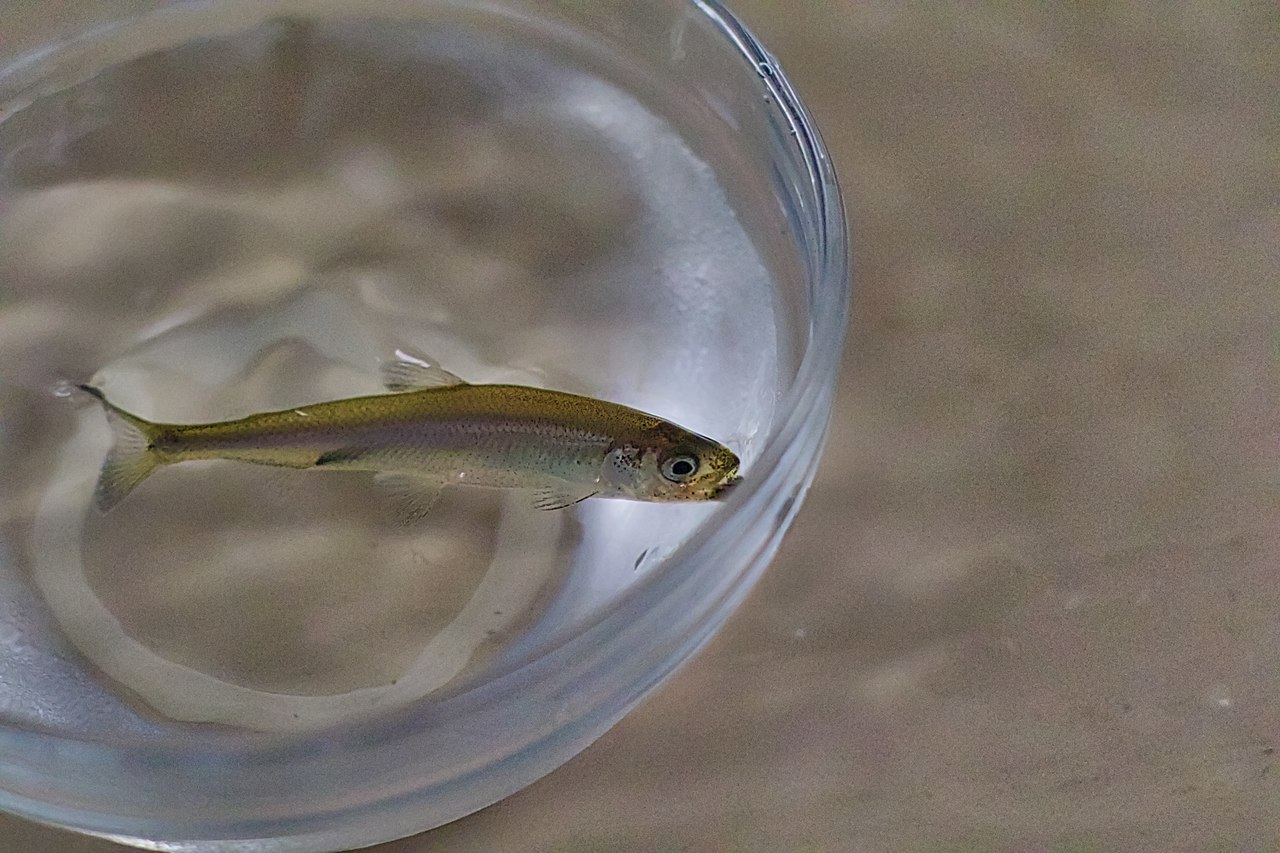Two species of tiny, drab, and otherwise forgettable fish—the blotchy brown snail darter and the pale, silvery delta smelt—will never meet in real life. The snail darter swims in rivers and streams in America's South and the delta smelt can only be found in a single estuary in California. But the fish have more in common than you might think. Both snail darters and delta smelt are freshwater fish that are native to the U.S. Both species have been listed as endangered at some point and subsequently become the lodestar of a controversial conservation battle. And both fish are in the news this week.
These two species collided in the news for seemingly different reasons—the darter starred in a new paper arguing it is actually not a distinct species, and the smelt was unlucky enough to become the subject of a tenuously coherent response from Donald Trump to a question about the L.A. wildfires. Two odd little fish making national headlines in one week might seem like a coincidence, but these fish are more entangled than they'll ever know. (How could they know? They're fish.) They tell a story about the process of science and conservation, and how blameless species become scapegoats for quagmires of our own making.
Maligned Little Fish No. 1: The Snail Darter

For millennia, the snail darter swam in the Little Tennessee River looking like gravel and eating snails (hence its name), without people noticing or caring. The fish grows to about the width of a hockey puck, which meant it was not a fish that anyone particularly wanted to eat. "I really love to see the look on someone's face when they see one live for the first time," Katrina Liebich, a public affairs specialist with the U.S. Fish and Wildlife Service in Alaska, said in an episode of the podcast Fish of the Week! "They're kind of like, 'Is that it? Really? That's it?' 'Yeah, that's it.'"
In 1967, the Tennessee Valley Authority began constructing a multi-million dollar dam on the Little Tennessee, which would transform the free-flowing river into a artificial reservoir. As the dam was underway, "many people, mostly locals, had been fighting against the construction of Tellico Dam," Chris Nagano, a retired USFWS endangered species biologist wrote on a post about the snail darter on his Substack. For example, the dam project would have forcefully evicted farmers from their lands and flooded ancestral sites of the Cherokee.
In 1973, the Endangered Species Act became law. That same year, a biologist from the University of Tennessee named David Etnier found a blotchy, brownish darter at the bottom of the Little Tennessee River. Etnier had never seen this fish before and would go on to describe it as a new species: Percina tanasi, or the snail darter. Environmentalists realized this rare fish, which was only found in the path of the dam, could be their best battering ram against construction. By 1975, the darter was listed as an endangered species.
The fish gained the ignominious honor of becoming the face of the fight against the dam, which many people reduced to extreme, over-reaching environmentalists exploiting a tiny fish for their own goals: "How did we allow this 2-inch fish with no economic significance to hold up a $1 billion dam project that would have provided energy and jobs to people?" RFK Jr. once told a reporter while standing over the decomposing body of a fox he had recently killed.
Reality was much more complicated. The dam was small and unneeded for electricity, NPR reported. And the snail darter was obviously not the only species that would be imperiled by its construction—just the one that offered the best legal case against the dam. "Depending how you looked at it, the darter-dam conflict was an inappropriate, unbalanced, campaign of self-appointed crusaders misusing a tiny fish to serve their own obstructionist ends—or it’s an instructive saga of citizen amateurs carrying a diminutive endangered fish like a warning symbol, a canary in the coal mine," Zygmunt Plater, the attorney who sued to protect the darter, wrote in a paper. Plater took the case to the Supreme Court and won, but Jimmy Carter ended up exempting the Tellico Dam from the Endangered Species Act, resulting in an operational dam by 1979.
Fast-forward to this week, when a group of researchers from Yale published a paper in Current Biology arguing that the snail darter, Percina tanasi, was never actually its own species, nor even a subspecies. Instead, the fish just another population of a fish called the stargazing darter, which is not endangered. The New York Times quoted one of the authors: "There is, technically, no snail darter." And this led to a slew of stories declaring the snail darter "isn't real" or that the environmentalists' decades-long scam was "finally debunked."
This is nonsense. The darters that swim in the Little Tennessee rivers have not vanished, nor have the unique problems facing this population gone away. And the concept of what exactly makes a species is and has long been hotly debated by people who are actually experts on the subject. How much do genetics matter, or appearance, or geography? This has led to one of the big rivalries in science: the lumpers versus the splitters. Lumpers lump species together; splitter split them. In the Times story on the new snail darter paper, Dr. Plater accused one of the authors of "lumping." In turn, that author said "being described as a 'lumper' was a pejorative in his world."
Fortunately, we do not have the time nor interest, currently, in adjudicating whether "lumper" is a slur. But despite how many people are framing the snail darter saga, this new paper is not some revelatory unmasking of an old environmentalist scam. Rather, it is a reflection on the fact that science is a process, one that develops over the years and consists of different approaches.
Perhaps the biggest takeaway is that the fish formerly known as the snail darter is doing great. In 2022, the population was officially taken off the threatened list, in part because of human interventions that routinely add fresh oxygen to the darters' dammed environment and clean the gravel where they spawn, NPR reported. If anything, it's a sign that species can recover when their existence is valued and the government takes action to protect them—a practice that will deteriorate over the next four years, one suspects.
Maligned Little Fish No. 2: Delta Smelt

Speaking of the next four years, Donald Trump invoked the other small and widely hated fish of the moment after a reporter asked if Trump believed federal aid should be provided to California to stave off the destruction of the wildfires, which have killed at least 10 people so far and forced more than 100,000 to evacuate. Trump, in turn, suggested that there could be "tremendous water" in California if it weren't for the delta smelt. Quoth the president-elect: "Because they’re trying to protect a tiny little fish, which is in other areas, by the way, called the smelt, and for the sake of a smelt, they have no water. They had no water in the fire hydrants today in Los Angeles, it’s a terrible thing."
Aside from the fact that "for the sake of a smelt" is a lovely turn of phrase, Trump's blaming the wildfire's spread on an innocent fish (its most distinct quality appears to be that it smells of cucumbers) is evocative of the same misplaced ire people once directed toward the snail darter. Trump actually has a longstanding beef with the delta smelt, a fish he has been railing against for nearly 10 years. But why?
Delta smelt, which grow just short of five inches in length, are silvery but otherwise forgettable fish that are only found in the San Francisco Estuary, which is, crucially, in Northern California and not near Los Angeles. But the smelt is just as controversial as the snail darter. Back in the 1970s, the delta smelt was abundant, swimming around the cool, turbid wetlands, feeding on plankton, and honorably serving as prey to salmon, people, and other predators. The population crashed in the '80s, and the smelt would first be listed as threatened under the ESA in 1993 and later re-listed as endangered in 2009.
Unfortunately, the delta smelt's problem is not as singular as a dam, but rather the single biggest problem facing California: water. The state depends on the Sacramento–San Joaquin Delta for fresh water, but over the years that water has been diverted to cities and farms, draining the wetlands and marshes that were once habitat for the smelt and many other species. But the smelt alone became an easy scapegoat for California's water problem, "because it is the first fish that was listed as endangered in the delta and because it’s easy to dislike it. No one ever sees it. No one fishes for it. It doesn’t really have a lobby," science writer Sharon Levy explained in a podcast for Undark.
Trump first mocked the hapless smelt in 2016 in Fresno. His people loved the smelt hate, and so the fish became one of his go-to punching bags, reported E&E News. His big promise: undoing all the delta smelt's protections would solve all of California's water problems. This is as untrue as his claim that the delta smelt is behind the scarcity of water available to Los Angeles firefighters. The L.A. fires, which erupted outside of traditional wildfire season, were stoked by dry winds, warm temperatures, and relentless drought, conditions that will only worsen with climate change, scientists told Reuters. The L.A. hydrant system is designed to quench house fires, not wildfires swallowing neighborhoods at a time. But accusing the smelt allows Trump to not only continue denying the effects of climate change, but also to pin the blame on some of the few environmental protections we have in place—in effect blaming environmentalists for the wildfires.
There is another, arguably more majestic fish from the delta that is imperiled by the same threats as the smelt: the Chinook salmon. The salmon swim in the same estuary as the smelt, but have the distinction of being a species of commercial and culinary value. "The practical implications of protecting Chinook salmon and the Delta Smelt are virtually indistinguishable," Caleb Scoville, a sociologist at Tufts University, wrote in a blog accompanying a paper on the delta smelt controversy. But Trump would never blame the wildfires on a beloved fish like a salmon because he could not characterize it as small and useless. And he would never put any of the blame on people like billionaires Stewart and Lynda Resnick, who use more water than every home in Los Angeles combined, as reported by Mother Jones.
So, whither the smelt? They are practically extinct in the wild. No one from the California fish and wildlife department has caught one since 2017. Soon there will be no delta smelt to blame, and then Republicans will have to find another scapegoat. Fortunately for them, researchers estimate that 83 percent of California's native freshwater fishes are at risk of extinction. Perhaps the next to go will be their cousins, the threatened longfin smelt. And when those disappear, it will be time for the steelhead trout and then the Chinook salmon. By then, the fires will only be worse.






